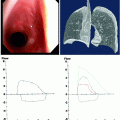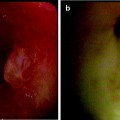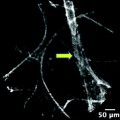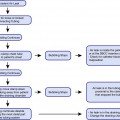Volume of pleural fluid
Physical examination findings
<250–300 cm3
Probable normal examination
500 cm3
1. Dullness to percussion
2. Decreased fremitus
3. Normal vesicular breath sounds but decreased intensity
1,000 cm3
1. Absence of inspiratory retraction, mild bulging of intercostal spaces
2. Decreased expansion of ipsilateral chest wall
3. Dullness to percussion up to the scapula and axilla
4. Decreased or absent fremitus posteriorly and laterally
5. Bronchovesicular breath sounds
6. Egophany (E to A change) at the upper level of the effusion
Massive (filling the hemithorax)
1. Bulging of intercostal spaces
2. Minimal to no ipsilateral chest wall expansion
3. Dull or flat percussion
4. Absent breath sounds
5. Egophany at the apex
6. Palpable liver or spleen due to diaphragmatic depression
Chest radiograph can aid in the differential diagnosis. If the effusion is bilateral, it is typically transudative (see below) and due to congestive heart failure, renal failure, or hypoalbuminemia. Cardiac enlargement is frequently seen in congestive heart failure. If a bilateral effusion is found to be exudative (see below), malignancy is most common, but can be seen with lupus pleuritis and rheumatoid pleurisy as well. When an isolated pleural effusion is the only abnormality, the physician should suspect infectious causes such as bacterial or tuberculous infections, in the right clinical setting. Rheumatoid pleurisy and lupus pleuritis can also present with an isolated effusion. Interstitial infiltrates in the setting of a pleural effusion are consistent with volume overload and congestive heart failure, rheumatoid disease, asbestos pulmonary disease, lymphangitic carcinomatosis, sarcoidosis, and lymphangioleiomyomatosis (LAM), among others. Nodular disease suggests malignancy but may also be seen with sarcoidosis and rheumatoid disease (Table 56.2).
Table 56.2
Chest radiograph findings of specific diseases
Chest radiograph findings | Diseases |
|---|---|
Unilateral effusion | Infection |
Lupus pleuritis | |
Rheumatoid pleurisy | |
Metastatic malignancy, non-Hodgkin lymphoma, leukemia | |
Pulmonary embolism | |
Drug-induced pleural disease | |
Yellow nail syndrome | |
Hypothyroidism | |
Uremic pleuritis | |
Chylothorax | |
Constrictive pericarditis | |
With mediastinal shift | Metastatic malignancy |
Without mediastinal shift | Lung cancer |
Malignant mesothelioma | |
Diseases below the diaphragm | Transudative: hepatic hydrothorax, nephritic syndrome, urinothorax, peritoneal dialysis |
Exudative: pancreatitis, Meigs syndrome, chylous ascites, subphrenic/hepatic/splenic abscess | |
Bilateral effusion | Transudative: congestive heart failure, nephrotic syndrome, hypoalbuminemia, peritoneal dialysis, constrictive pericarditis |
Exudative: malignancy, lupus pleuritis, rheumatoid pleurisy | |
Associated with interstitial infiltrates | Congestive heart failure |
Rheumatoid disease | |
Asbestos pulmonary disease | |
Lymphangioleiomyomatosis (LAM) | |
Viral and mycoplasma pneumonia | |
Sarcoidosis | |
Pneumocystis jiroveci pneumonia | |
Associated with multiple nodules | Cancer |
Wegener granulomatosis | |
Rheumatoid disease | |
Septic pulmonary embolism | |
Sarcoidosis | |
Tularemia |
Pleural Fluid Analysis: Briefly
Pleural fluid can establish a definitive diagnosis in a limited number of diseases, such as empyema, malignancy, chylothorax, and rheumatoid pleurisy. However, it is highly useful in excluding potentially harmful diseases that would warrant immediate intervention, such as empyema.
Initial evaluation of the fluid is performed at the time of thoracentesis, as the fluid is aspirated. Careful attention should be paid to the color (straw colored, serosanguinous, bloody, white), consistency (pus, turbid, debris), and odor (foul smelling) of the fluid.
After visual inspection during the procedure, the fluid is sent for laboratory analysis. Broad classification of the fluid into transudative or exudative by chemical analysis is performed (Tables 56.3 and 56.4). Richard Light established a well-known algorithm for distinguishing an exudative pleural effusion based on three tests: (a) pleural fluid lactate dehydrogenase (LDH) >two-thirds the laboratory’s upper limit of normal for serum, (b) pleural fluid to serum LDH ratio >0.6, and (c) pleural fluid to serum protein ratio >0.5. Only one of these results needs to be positive to confirm an exudative effusion. Light’s criteria has a diagnostic accuracy over 90 % but drops significantly to below 70–80 % if one of the three categories is borderline. Pleural fluid can also be analyzed for a number of other laboratory tests, including but not exclusive, to glucose, pH, amylase, cholesterol, albumin, B-type natriuretic peptide (BNP), and adenosine deaminase (ADA). There are many other tests and ways to analyze the pleural fluid from a thoracentesis, but that is outside the scope of this chapter.
Table 56.3
Causes of exudative pleural effusions
Causes | ||
Infectious | Malignancy | Connective tissue disease |
Bacterial pneumonia | Carcinoma | Lupus pleuritis |
Tuberculous effusion | Lymphoma | Rheumatoid pleurisy |
Fungal disease | Mesothelioma | Mixed connective tissue disease |
Atypical pneumonias | Leukemia | Sjögren syndrome |
Nocardia, Actinomyces | Chylothorax | |
Subphrenic abscess | ||
Hepatic abscess | Other inflammatory | Endocrine dysfunction |
Splenic abscess | Pancreatitis | Hypothyroidism |
Hepatitis | BAPE | Ovarian hyperstimulation syndrome |
Spontaneous esophageal rupture | Pulmonary infarction | |
Parasites | Radiation therapy | Lymphatic abnormalities |
Sarcoidosis | Malignancy | |
Iatrogenic | PCIS | Chylothorax |
Drug-induced | Hemothorax | Yellow nail syndrome |
Esophageal perforation | ARDS | Lymphangiomyomatosis (chylothorax) |
Esophageal sclerotherapy | Cholesterol effusion | Lymphangiectasis |
Central venous catheter misplacement/migration | ||
Enteral feeding tube in pleural space | ||
Increased negative intrapleural pressure | Movement of fluid from abdomen to pleural space | |
Atelectasis | Acute pancreatitis | |
Vasculitis | Trapped lung | Pancreatic pseudocyst |
Wegener granulomatosis | Meigs syndrome | |
Churg–Strauss syndrome | Carcinoma | |
Familial Mediterranean fever | Chylous ascites | |









